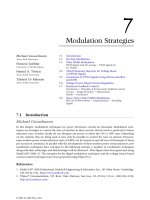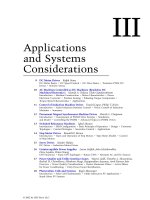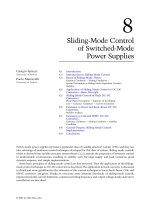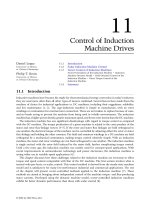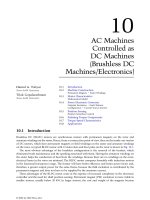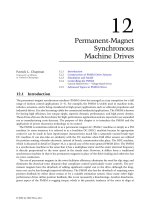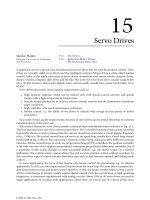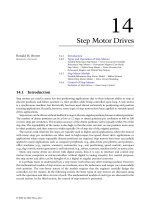AC power systems handbook
Bạn đang xem bản rút gọn của tài liệu. Xem và tải ngay bản đầy đủ của tài liệu tại đây (16.78 MB, 405 trang )
AC
Power Systems
Handbook
Third Edition
Jerry C. Whitaker
Technical Press
Morgan Hill, California
Boca Raton London New York
CRC Press is an imprint of the
Taylor & Francis Group, an informa business
© 2007 by Taylor & Francis Group, LLC
4034_Discl.fm Page 1 Friday, August 25, 2006 10:06 AM
Published in 2007 by
CRC Press
Taylor & Francis Group
6000 Broken Sound Parkway NW, Suite 300
Boca Raton, FL 33487-2742
© 2007 by Taylor & Francis Group, LLC
CRC Press is an imprint of Taylor & Francis Group
No claim to original U.S. Government works
Printed in the United States of America on acid-free paper
10 9 8 7 6 5 4 3 2 1
International Standard Book Number-10: 0-8493-4034-9 (Hardcover)
International Standard Book Number-13: 978-0-8493-4034-5 (Hardcover)
Library of Congress Card Number 2006042620
This book contains information obtained from authentic and highly regarded sources. Reprinted material is quoted with
permission, and sources are indicated. A wide variety of references are listed. Reasonable efforts have been made to publish
reliable data and information, but the author and the publisher cannot assume responsibility for the validity of all materials
or for the consequences of their use.
No part of this book may be reprinted, reproduced, transmitted, or utilized in any form by any electronic, mechanical, or
other means, now known or hereafter invented, including photocopying, microfilming, and recording, or in any information
storage or retrieval system, without written permission from the publishers.
For permission to photocopy or use material electronically from this work, please access www.copyright.com
( or contact the Copyright Clearance Center, Inc. (CCC) 222 Rosewood Drive, Danvers, MA
01923, 978-750-8400. CCC is a not-for-profit organization that provides licenses and registration for a variety of users. For
organizations that have been granted a photocopy license by the CCC, a separate system of payment has been arranged.
Trademark Notice: Product or corporate names may be trademarks or registered trademarks, and are used only for
identification and explanation without intent to infringe.
Library of Congress Cataloging-in-Publication Data
Whitaker, Jerry C.
AC power systems / Jerry C. Whitaker.--3rd ed.
p. cm.
Includes bibliographical references and index.
ISBN 0-8493-4034-9 (alk. paper)
1. Electric power distribution--Alternating current--Handbooks, manuals, etc. 2. Electric power
systems--Protection--Handbooks, manuals, etc. I. Title.
TK3141.W45 2006
621.319’13--dc22
2006042620
Visit the Taylor & Francis Web site at
Taylor & Francis Group
is the Academic Division of Informa plc.
© 2007 by Taylor & Francis Group, LLC
and the CRC Press Web site at
For Jenny and Andy,
very special people
v
© 2007 by Taylor & Francis Group, LLC
Table of Contents
Preface ................................................................................................................................................. xvii
About the Author ........................................................................................................................... xix
Chapter 1
AC Power Systems
1.1 Introduction ..................................................................................................................1
1.1.1 Defining Terms ................................................................................................... 1
1.1.2 Power Electronics ............................................................................................... 3
1.2 AC Circuit Analysis ...................................................................................................... 4
1.2.1 Power Relationship in AC Circuits ................................................................... 4
1.2.2 Complex Numbers ............................................................................................ 4
1.2.3 Phasors ................................................................................................................ 6
1.2.4 Per Unit System .................................................................................................. 6
1.3 Elements of the AC Power System .............................................................................. 7
1.3.1 Transmission Circuits ........................................................................................ 7
1.3.1.1 Types of Conductors ............................................................................ 8
1.3.1.2 Overhead Conductors ........................................................................... 8
1.3.1.3 Underground Cables ........................................................................... 10
1.3.1.4 Skin Effect ........................................................................................... 10
1.3.2 Dielectrics and Insulators ................................................................................ 11
1.3.2.1 Insulating Liquids ............................................................................... 12
1.3.2.2 Insulating Solids .................................................................................. 13
1.3.3 Control and Switching Systems ...................................................................... 14
1.3.3.1 Fault Protection Devices .................................................................... 15
1.3.3.2 Lightning Arrester ............................................................................... 16
1.4 Utility AC Power System Architecture ...................................................................... 16
1.4.1 Power Distribution .......................................................................................... 18
1.4.2 Distribution Substations .................................................................................. 18
1.4.2.1 Breaker Schemes ................................................................................. 20
1.4.3 Voltage Analysis ................................................................................................ 22
1.4.4 High-Voltage DC Transmission ...................................................................... 22
1.4.4.1 AC vs. DC Transmission .................................................................... 24
1.4.4.2 DC Circuit Breakers ............................................................................ 25
1.4.5 Utility Company Interfacing ........................................................................... 26
1.4.5.1 Phase-to-Phase Balance ....................................................................... 27
1.4.6 Load Fault Protection ...................................................................................... 27
1.4.6.1 Fuses ..................................................................................................... 28
1.4.6.2 Circuit Breakers ................................................................................... 28
1.4.6.3 Semiconductor Fuses .......................................................................... 28
vii
© 2007 by Taylor & Francis Group, LLC
Chapter 2
Chapter 3
Chapter 4
1.4.6.4 Application Considerations ................................................................ 29
1.4.6.5 Transient Currents .............................................................................. 29
1.4.6.6 Delay-Trip Considerations ................................................................. 30
1.4.7 Measuring AC Power ....................................................................................... 31
1.4.7.1 Digital Measurement Techniques ...................................................... 32
1.5 References .................................................................................................................... 33
1.6 Bibliography ................................................................................................................ 34
Power-Generation Systems
2.1 Introduction ................................................................................................................ 35
2.2 Fundamental Concepts .............................................................................................. 35
2.2.1 Operating Principles ........................................................................................ 35
2.2.2 Control Techniques .......................................................................................... 39
2.3 Power-Generating Systems ......................................................................................... 40
2.3.1 Fossil Fuel Power Plants .................................................................................. 40
2.3.2 Nuclear Power Plants ....................................................................................... 44
2.3.3 Hydroelectric Power Plants ............................................................................. 45
2.4 References .................................................................................................................... 48
2.5 Bibliography ................................................................................................................ 48
Power Factor
3.1 Introduction ................................................................................................................ 49
3.2 Fundamental Principles ............................................................................................. 49
3.3 PF Correction Techniques .......................................................................................... 52
3.3.1 On-Site Power Factor Correction ................................................................... 53
3.3.2 Shunt Reactors ................................................................................................. 55
3.3.3 Unwanted Resonance Conditions ................................................................... 55
3.3.4 Series Capacitor Compensation ...................................................................... 56
3.3.5 Static Compensation Devices .......................................................................... 57
3.4 References .................................................................................................................... 58
3.5 Bibliography ................................................................................................................ 58
Power Transformers
4.1 Introduction ................................................................................................................ 59
4.2 Inductive Properties ................................................................................................... 59
4.2.1 Coils .................................................................................................................. 60
4.2.2 The Toroid ........................................................................................................ 61
4.2.3 Circuit Description of Self-Inductance .......................................................... 61
4.2.4 Magnetic Materials ........................................................................................... 62
4.3 Basic Principles of the Transformer .......................................................................... 62
4.3.1 Counter-Electromotive Force .......................................................................... 68
4.3.2 Full Load Percent Impedance .......................................................................... 68
4.3.3 Design Considerations ..................................................................................... 69
4.3.4 The Ideal Transformer ..................................................................................... 71
4.3.5 Application Considerations ............................................................................. 72
4.4 Transformer Failure Modes ....................................................................................... 75
4.4.1 Thermal Considerations .................................................................................. 76
viii
© 2007 by Taylor & Francis Group, LLC
Chapter 5
Chapter 6
4.4.1.1 Life Expectancy and Temperature ..................................................... 76
4.4.2 Voltage Considerations .................................................................................... 76
4.4.3 Mechanical Considerations ............................................................................. 77
4.4.3.1 Dry-Type and Liquid-Filled Transformers ....................................... 77
4.4.3.2 Insulation Materials ............................................................................ 78
4.4.3.3 Insulating Liquids ............................................................................... 78
4.4.3.4 Cooling ................................................................................................ 79
4.5 References .................................................................................................................... 79
4.6 Bibliography ................................................................................................................. 79
Capacitors
5.1 Introduction ................................................................................................................ 81
5.2 Basic Principles ........................................................................................................... 81
5.2.1 Series and Parallel Connections ...................................................................... 85
5.2.2 Practical Capacitors ......................................................................................... 86
5.3 Capacitor Failure Modes ............................................................................................ 86
5.3.1 Electrolytic Capacitors ..................................................................................... 86
5.3.1.1 Mechanical Failure .............................................................................. 88
5.3.1.2 Temperature Cycling ........................................................................... 89
5.3.1.3 Electrolyte Failures .............................................................................. 89
5.3.2 Capacitor Life Span .......................................................................................... 90
5.3.3 Tantalum Capacitor ......................................................................................... 91
5.4 References .................................................................................................................... 91
5.5 Bibliography ................................................................................................................ 92
Semiconductors
6.1 Introduction ................................................................................................................ 93
6.2 Semiconductor Failure Modes ................................................................................... 93
6.2.1 Device Ruggedness ........................................................................................... 93
6.2.2 Forward Bias Safe Operating Area .................................................................. 94
6.2.3 Reverse Bias Safe Operating Area ................................................................... 94
6.2.4 Power-Handling Capability ............................................................................. 95
6.2.5 Semiconductor Derating ................................................................................. 95
6.2.6 Failure Mechanisms ......................................................................................... 96
6.2.6.1 Avalanche Breakdown ......................................................................... 96
6.2.6.2 Alpha Multiplication ........................................................................... 96
6.2.6.3 Punch-Through ................................................................................... 96
6.2.6.4 Thermal Runaway ............................................................................... 97
6.3 MOSFET Devices ........................................................................................................ 97
6.3.1 Safe Operating Area ......................................................................................... 97
6.3.2 MOSFET Failure Modes ................................................................................ 101
6.3.3 Breakdown Effects .......................................................................................... 101
6.3.3.1 Thermal Second Breakdown ............................................................ 102
6.3.3.2 Metallization Failure ......................................................................... 102
6.3.3.3 Polarity Reversal ................................................................................ 102
6.4 Thyristor Components ............................................................................................. 103
6.4.1 Failure Modes ................................................................................................. 104
6.4.2 Application Considerations ........................................................................... 104
ix
© 2007 by Taylor & Francis Group, LLC
6.5
Chapter 7
Chapter 8
ESD Failure Modes ................................................................................................... 104
6.5.1 Failure Mechanisms ....................................................................................... 105
6.5.1.1 Latent Failures ................................................................................... 107
6.5.1.2 Case in Point ..................................................................................... 107
6.6 Semiconductor Development .................................................................................. 107
6.6.1 Failure Analysis .............................................................................................. 108
6.6.2 Chip Protection .............................................................................................. 111
6.7 Effects of Arcing ....................................................................................................... 111
6.7.1 Insulation Breakdown .................................................................................... 112
6.8 References .................................................................................................................. 112
6.9 Bibliography .............................................................................................................. 112
Rectifier and Filter Circuits
7.1 Introduction ............................................................................................................... 115
7.2 Power Rectifiers ........................................................................................................ 116
7.2.1 Operating Rectifiers in Series ........................................................................ 116
7.2.2 Operating Rectifiers in Parallel ..................................................................... 117
7.2.3 Silicon Avalanche Rectifiers ........................................................................... 118
7.2.4 Single-Phase Rectifier Configurations .......................................................... 119
7.2.4.1 Half-Wave Rectifier ........................................................................... 119
7.2.4.2 Full-Wave Rectifier ............................................................................ 120
7.2.4.3 Bridge Rectifier .................................................................................. 121
7.2.4.4 Voltage Multiplier ............................................................................. 122
7.2.5 Polyphase Rectifier Circuits ........................................................................... 122
7.3 Power Supply Filter Circuits .................................................................................... 125
7.3.1 Inductive Input Filter .................................................................................... 125
7.3.2 Capacitive Input Filter ................................................................................... 127
7.4 References .................................................................................................................. 129
7.5 Bibliography .............................................................................................................. 129
Power Electronics
8.1 Introduction .............................................................................................................. 131
8.2 Thyristor Devices ...................................................................................................... 131
8.2.1 Thyristor Servo Systems ................................................................................ 132
8.2.1.1 Inductive Loads ................................................................................. 133
8.2.1.2 Applications ....................................................................................... 134
8.2.1.3 Triggering Circuits ............................................................................ 137
8.2.1.4 Control Flexibility ............................................................................. 139
8.2.2 Gate Turn-Off Thyristor ................................................................................ 139
8.2.3 Reverse-Conducting Thyristor ...................................................................... 139
8.2.4 Asymmetrical Silicon-Controlled Rectifier .................................................. 140
8.2.5 Fusing .............................................................................................................. 140
8.3 Power Transistors ...................................................................................................... 140
8.3.1 Power MOSFET .............................................................................................. 141
8.3.1.1 Rugged MOSFET .............................................................................. 141
8.3.2 Insulated-Gate Bipolar Transistor ................................................................. 142
8.3.3 MOS-Controlled Thyristor ........................................................................... 143
8.4 References .................................................................................................................. 143
x
© 2007 by Taylor & Francis Group, LLC
8.5 Bibliography .............................................................................................................. 143
Chapter 9 Origins of AC Line Disturbances
9.1 Introduction .............................................................................................................. 145
9.2 Naturally Occurring Disturbances .......................................................................... 145
9.2.1 Sources of Atmospheric Energy .................................................................... 145
9.2.2 Characteristics of Lightning .......................................................................... 147
9.2.2.1 Cloud-to-Cloud Activity .................................................................. 149
9.2.3 Lightning Protection ...................................................................................... 150
9.2.3.1 Protection Area ................................................................................. 151
9.2.4 Electrostatic Discharge ................................................................................... 153
9.2.4.1 Triboelectric Effect ............................................................................ 154
9.2.5 EMP Radiation ............................................................................................... 155
9.2.6 Coupling Transient Energy ........................................................................... 156
9.3 Equipment-Caused Transient Disturbances ........................................................... 157
9.3.1 Utility System Faults ...................................................................................... 158
9.3.2 Switch Contact Arcing ................................................................................... 158
9.3.3 Telephone System Transients ........................................................................ 159
9.3.4 Nonlinear Loads and Harmonic Energy ...................................................... 161
9.3.4.1 Harmonic Sources ............................................................................ 164
9.3.5 Carrier Storage ............................................................................................... 165
9.3.6 Transient-Generated Noise ............................................................................ 166
9.3.6.1 ESD Noise .......................................................................................... 166
9.3.6.2 Contact Arcing .................................................................................. 166
9.3.6.3 SCR Switching ................................................................................... 166
9.4 References .................................................................................................................. 167
9.5 Bibliography .............................................................................................................. 167
Chapter 10 Power Disturbance Characterization
10.1 Introduction .............................................................................................................. 169
10.2 Standards of Measurement ...................................................................................... 170
10.2.1 Assessing the Threat .................................................................................. 173
10.2.2 Fundamental Measurement Techniques .................................................. 173
10.2.2.1 Root-Mean-Square ................................................................. 173
10.2.2.2 Average-Response Measurement ........................................... 174
10.2.2.3 Peak-Response Measurement ................................................ 174
10.2.2.4 Meter Accuracy ....................................................................... 176
10.2.3 Digital Measurement Instruments ............................................................ 177
10.2.4 Digital Monitor Features ........................................................................... 178
10.3 Reliability Considerations ........................................................................................ 179
10.4 References .................................................................................................................. 179
10.5 Bibliography .............................................................................................................. 179
Chapter 11 Power System Protection Methods
11.1 Introduction .............................................................................................................. 181
11.2 The Key Tolerance Envelope .................................................................................... 181
11.3 Assessing the Lightning Hazard .............................................................................. 183
11.4 FIPS Publication 94 .................................................................................................. 184
11.5 Protection Alternatives ............................................................................................. 185
xi
© 2007 by Taylor & Francis Group, LLC
11.5.1 Specifying System-Protection Hardware .................................................. 187
11.6 References .................................................................................................................. 189
11.7 Bibliography .............................................................................................................. 189
Chapter 12 Motor-Generator Set
12.1 Introduction .............................................................................................................. 191
12.2 System Configuration ............................................................................................... 191
12.2.1 Motor Design Considerations ................................................................... 194
12.2.1.1 Single-Shaft Systems ............................................................... 195
12.2.2 Flywheel Considerations ........................................................................... 196
12.2.3 Maintenance Considerations .................................................................... 197
12.2.4 Motor-Generator UPS ............................................................................... 197
12.2.5 Kinetic Battery Storage System ................................................................. 199
12.3 References .................................................................................................................. 201
12.4 Bibliography .............................................................................................................. 201
Chapter 13 Uninterruptible Power Systems
13.1 Introduction .............................................................................................................. 203
13.2 UPS Configuration ................................................................................................... 203
13.2.1 Power-Conversion Methods ..................................................................... 205
13.2.1.1 Ferroresonant Inverter ........................................................... 205
13.2.1.2 Delta Magnetic Inverter ......................................................... 206
13.2.1.3 Inverter-Fed L/C Tank ........................................................... 207
13.2.1.4 Quasi-Square Wave Inverter .................................................. 207
13.2.1.5 Step Wave Inverter ................................................................. 209
13.2.1.6 Pulse-Width Modulation Inverter ......................................... 209
13.2.1.7 Phase Modulation Inverter .................................................... 209
13.2.2 Redundant Operation ................................................................................ 209
13.2.3 Output Transfer Switch ............................................................................. 212
13.2.4 Battery Supply ............................................................................................ 213
13.3 References .................................................................................................................. 213
13.4 Bibliography .............................................................................................................. 213
Chapter 14 Power Conditioning Devices
14.1 Introduction .............................................................................................................. 215
14.2 Ferroresonant Transformer ...................................................................................... 215
14.2.1 Magnetic-Coupling-Controlled Voltage Regulator ................................. 216
14.3 Isolation Transformer ............................................................................................... 217
14.3.1 Tap-Changing Regulator ........................................................................... 219
14.3.1.1 Variable Ratio Regulator ........................................................ 220
14.3.2 Variable Voltage Transformer .................................................................. 221
14.3.2.1 Brush Type .............................................................................. 222
14.3.2.2 Induction Type ....................................................................... 222
14.4 Line Conditioner ...................................................................................................... 222
14.4.1 Hybrid Transient Suppressor .................................................................... 224
14.4.2 Active Power-Line Conditioner ................................................................ 224
14.4.2.1 Application Considerations ................................................... 226
14.5 References .................................................................................................................. 226
14.6 Bibliography .............................................................................................................. 226
xii
© 2007 by Taylor & Francis Group, LLC
Chapter 15 Transient-Suppression Devices
15.1 Introduction .............................................................................................................. 227
15.2 Filter Devices ............................................................................................................. 227
15.3 Crowbar Devices ....................................................................................................... 229
15.3.1 Characteristics of Arcs ............................................................................... 229
15.4 Voltage-Clamping Devices ....................................................................................... 229
15.4.1 Zener Components .................................................................................... 234
15.4.2 Hybrid Suppression Circuits ..................................................................... 237
15.5 Selecting Protection Components ........................................................................... 238
15.6 References .................................................................................................................. 238
15.7 Bibliography .............................................................................................................. 239
Chapter 16 Facility Wiring and Transient Protection
16.1 Introduction .............................................................................................................. 241
16.2 Facility Wiring .......................................................................................................... 241
16.2.1 Utility Service Entrance ............................................................................. 243
16.3 Power-System Protection ......................................................................................... 245
16.3.1 Staging ........................................................................................................ 245
16.3.2 Design Cautions ......................................................................................... 248
16.3.2.1 Specifications .......................................................................... 248
16.3.3 Single-Phasing ............................................................................................ 249
16.3.4 Surge Suppressor Selection ....................................................................... 249
16.4 References .................................................................................................................. 251
16.5 Bibliography .............................................................................................................. 251
Chapter 17 Circuit-Level Transient Suppression
17.1 Introduction .............................................................................................................. 253
17.2 Protecting Low-Voltage Supplies ............................................................................. 253
17.3 Protecting High-Voltage Supplies ............................................................................ 253
17.4 RF System Protection ............................................................................................... 257
17.5 Protecting Logic Circuits ......................................................................................... 257
17.6 Protecting Telco Lines .............................................................................................. 258
17.7 Inductive Load Switching ........................................................................................ 261
17.8 Bibliography .............................................................................................................. 261
Chapter 18 Grounding Practices
18.1 Introduction .............................................................................................................. 263
18.1.1 Terms and Codes ....................................................................................... 263
18.2 The Need for Grounding ......................................................................................... 263
18.2.1 Equipment Grounding .............................................................................. 264
18.2.2 System Grounding ..................................................................................... 264
18.2.3 The Grounding Electrode .......................................................................... 267
18.2.4 Earth Electrode .......................................................................................... 268
18.3 Establishing an Earth Ground ................................................................................. 268
18.3.1 Grounding Interface .................................................................................. 268
18.3.1.1 Ground Electrode Testing ...................................................... 273
18.3.2 Chemical Ground Rods ............................................................................. 273
18.3.3 Ufer Ground System .................................................................................. 274
18.3.4 Bonding Ground-System Elements .......................................................... 277
xiii
© 2007 by Taylor & Francis Group, LLC
18.3.5 Exothermic Bonding .................................................................................. 277
18.3.6 Ground-System Inductance ...................................................................... 278
18.4 References .................................................................................................................. 280
18.5 Bibliography .............................................................................................................. 281
Chapter 19 Grounding Tower Elements
19.1 Introduction .............................................................................................................. 283
19.2 Ground-Wire Dressing ............................................................................................. 283
19.3 Facility Ground Interconnection ............................................................................. 284
19.3.1 Personnel Protection ................................................................................. 285
19.4 Grounding on Bare Rock ......................................................................................... 288
19.4.1 Rock-Based Radial Elements ..................................................................... 288
19.5 Transmission-System Grounding ............................................................................ 289
19.5.1 Transmission Line ..................................................................................... 289
19.5.2 Cable Considerations ................................................................................ 289
19.5.3 Satellite Antenna Grounding .................................................................... 290
19.6 References .................................................................................................................. 292
Chapter 20 Facility Ground-System Design
20.1 Introduction .............................................................................................................. 293
20.2 Bulkhead Grounding ................................................................................................ 293
20.2.1 Bulkhead Panel .......................................................................................... 297
20.2.2 Lightning Protectors .................................................................................. 299
20.2.2.1 Typical Installation ................................................................. 300
20.2.3 Checklist for Proper Grounding ............................................................... 302
20.3 AC System Grounding Practices .............................................................................. 303
20.3.1 Building Codes ........................................................................................... 303
20.3.1.1 Single-Point Ground .............................................................. 304
20.3.2 Isolated Grounding .................................................................................... 304
20.3.3 Separately Derived Systems ....................................................................... 305
20.3.4 Grounding Terminology ........................................................................... 305
20.3.5 Facility Ground System ............................................................................. 306
20.3.5.1 Grounding Conductor Size .................................................... 309
20.3.5.2 High-Frequency Effects .......................................................... 311
20.3.6 Power-Center Grounding ......................................................................... 311
20.3.6.1 Isolation Transformers ........................................................... 313
20.4 Grounding Equipment Racks .................................................................................. 314
20.5 Grounding Signal Cables ......................................................................................... 316
20.5.1 Analyzing Noise Currents ......................................................................... 316
20.5.2 Types of Noise ............................................................................................ 317
20.5.3 Noise Control ............................................................................................. 318
20.6 Patch-Bay Grounding ............................................................................................... 320
20.7 Cable Routing ........................................................................................................... 321
20.7.1 Overcoming Ground-System Problems ................................................... 322
20.8 References .................................................................................................................. 322
20.9 Bibliography .............................................................................................................. 322
Chapter 21 Standby Power Systems
21.1 Introduction .............................................................................................................. 325
xiv
© 2007 by Taylor & Francis Group, LLC
21.1.1 Blackout Effects .......................................................................................... 325
21.2 Standby Power Options ............................................................................................ 326
21.2.1 Dual-Feeder System ................................................................................... 326
21.2.2 Peak Power Shaving ................................................................................... 328
21.2.3 Advanced System Protection .................................................................... 329
21.2.4 Choosing a Generator ................................................................................ 329
21.2.4.1 Generator Types ...................................................................... 332
21.2.5 UPS Systems ............................................................................................... 333
21.2.6 Standby Power-System Noise ................................................................... 333
21.2.7 Batteries ...................................................................................................... 334
21.2.7.1 Terms ....................................................................................... 334
21.2.7.2 Sealed Lead-Acid Battery ........................................................ 335
21.3 References .................................................................................................................. 336
21.4 Bibliography .............................................................................................................. 336
Chapter 22 Designing for Fault-Tolerance
22.1 Introduction .............................................................................................................. 337
22.2 Critical System Bus ................................................................................................... 337
22.2.1 Power-Distribution Options ..................................................................... 338
22.2.2 Plant Configuration ................................................................................... 340
22.3 Plant Maintenance .................................................................................................... 341
22.3.1 Switchgear Maintenance ........................................................................... 342
22.3.2 Ground-System Maintenance ................................................................... 342
22.4 References .................................................................................................................. 344
22.5 Bibliography ............................................................................................................... 344
Chapter 23 The Efficient Use of Energy
23.1 Introduction .............................................................................................................. 345
23.2 Energy Usage ............................................................................................................. 345
23.3 Peak Demand ............................................................................................................ 346
23.4 Load Factor ...............................................................................................................347
23.5 Power Factor .............................................................................................................. 347
23.6 References .................................................................................................................. 349
23.7 Bibliography .............................................................................................................. 349
Chapter 24 Safety and Protection Systems
24.1 Introduction .............................................................................................................. 351
24.1.1 Facility Safety Equipment.......................................................................... 351
24.2 Electric Shock ........................................................................................................... 353
24.2.1 Effects on the Human Body ...................................................................... 353
24.2.2 Circuit-Protection Hardware .................................................................... 355
24.2.3 Working with High Voltage ...................................................................... 358
24.2.4 First Aid Procedures .................................................................................. 358
24.2.4.1 Shock in Progress .................................................................... 360
24.2.4.2 Shock No Longer in Progress ................................................. 360
24.3 Polychlorinated Biphenyls ........................................................................................ 361
24.3.1 Health Risk ................................................................................................. 361
24.3.2 Governmental Action ................................................................................ 362
24.3.3 PCB Components ...................................................................................... 362
xv
© 2007 by Taylor & Francis Group, LLC
24.3.4 Identifying PCB Components ................................................................... 364
24.3.5 Labeling PCB Components ....................................................................... 364
24.3.6 Record-Keeping ......................................................................................... 365
24.3.7 Disposal ...................................................................................................... 366
24.3.8 Proper Management .................................................................................. 366
24.4 OSHA Safety Requirements ..................................................................................... 367
24.4.1 Protective Covers ....................................................................................... 368
24.4.2 Identification and Marking ....................................................................... 368
24.4.3 Extension Cords ......................................................................................... 368
24.4.4 Grounding .................................................................................................. 368
24.4.5 Management Responsibility ...................................................................... 369
24.5 References .................................................................................................................. 371
24.6 Bibliography .............................................................................................................. 371
Chapter 25 Reference Data and Tables
25.1 Standard Electrical Units ......................................................................................... 373
25.1.1 Standard Prefixes ....................................................................................... 374
25.1.2 Common Standard Units .......................................................................... 375
25.2 Reference Tables ........................................................................................................ 376
25.2.1 Power Conversion Factors ........................................................................ 376
25.2.2 Standing Wave Ratio ................................................................................. 377
25.2.3 Specifications of Standard Copper Wire Sizes ......................................... 378
25.2.4 Celsius-to-Fahrenheit Conversion Table ................................................. 379
25.2.5 Inch-to-Millimeter Conversion Table ...................................................... 380
25.2.6 Conversion of Millimeters to Decimal Inches ......................................... 381
25.2.7 Conversion of Common Fractions to Decimal and Millimeter Units .... 382
25.2.8 Decimal Equivalent Size of Drill Numbers .............................................. 383
25.2.9 Decimal Equivalent Size of Drill Letters ................................................... 383
25.2.10
Conversion Ratios for Length ................................................ 384
25.2.11
Conversion Ratios for Area .................................................... 384
25.2.12
Conversion Ratios for Mass ................................................... 385
25.2.13
Conversion Ratios for Volume .............................................. 385
25.2.14
Conversion Ratios for Cubic Measure ................................... 386
25.2.15
Conversion Ratios for Electrical Quantities .......................... 386
Chapter 26 Units Conversion Table
26.1 Quantity Conversion ................................................................................................ 387
© 2007 by Taylor & Francis Group, LLC
Preface
Disturbances on the ac power line are what headaches are made of. Outages, surges, sags, transients: they
combine to create an environment that can damage or destroy sensitive load equipment. They can take
your system down and leave you with a complicated and expensive repair job.
Ensuring that the equipment at your facility receives clean ac power has always been important. But
now, with computers integrated into a wide variety of electronic products, the question of ac power
quality is more critical than ever. The computer-based systems prevalent today can garble or lose data
because of power-supply disturbances or interruptions. And if the operational problems are not enough,
there is the usually difficult task of equipment troubleshooting and repair that follows a utility system
fault.
This book examines the key elements of ac power use for commercial and industrial customers. The
roots of ac power-system problems are identified, and effective solutions are detailed. The book follows
a logical progression from generating ac energy to the protection of life and property. General topics
include:
• Power-System Operation. Every electronic installation requires a steady supply of clean power to
function properly. The ac power line into a facility is, in fact, the lifeblood of any operation. It is also,
however, a frequent source of equipment malfunctions and component failures. This book details the
process of generating ac energy and distributing it to end-users. The causes of power-system disturbances are detailed, and the characteristics of common fault conditions are outlined.
• Protecting Equipment Loads. Power quality is a moving target. Utility companies work hard to maintain acceptable levels of performance. However, the wide variety of loads and unpredictable situations
make this job difficult. Users cannot expect power suppliers to solve all their problems. Responsibility
for protecting sensitive loads clearly rests with the end-user. Several chapters are devoted to this
important topic. Power-system protection options are outlined, and their relative benefits discussed.
Evaluating the many tradeoffs involved in protection system design requires a thorough knowledge of
the operating principles.
• How Much Protection? The degree of protection afforded a facility is generally a compromise
between the line abnormalities that will account for most of the expected problems and the amount of
money available to spend on that protection. Each installation is unique and requires an assessment of
the importance of keeping the system up and running at all times, as well as the threat of disturbances
posed by the ac feed to the plant. The author firmly believes that the degree of protection provided a
power-distribution system should match the threat of system failure. In this publication, all alternatives are examined with an eye toward deciding how much protection really is needed, and how much
money can be justified for ac protection hardware.
• Grounding. The attention given to the design and installation of a facility ground system is a key element in the day-to-day reliability of any plant. A well-planned ground network is invisible to the
xvii
© 2007 by Taylor & Francis Group, LLC
engineering staff. A marginal ground system, however, will cause problems on a regular basis.
Although most engineers view grounding primarily as a method to protect equipment from damage
or malfunction, the most important element is operator safety. The 120 V or 208 V ac line current that
powers most equipment can be dangerous — even deadly — if improperly handled. Grounding of
equipment and structures provides protection against wiring errors or faults that could endanger
human life. Grounding concepts and practices are examined in detail. Clear, step-by-step guidelines
are given for designing and installing an effective ground system to achieve good equipment performance, and to provide for operator safety.
• Standby Power. Blackouts are, without a doubt, the most troublesome utility company problem that a
facility will have to deal with. Statistics show that power failures are, generally speaking, a rare occurrence in most areas of the country. They also are usually short in duration. Typical failure rates are not
normally cause for alarm to commercial users, except where computer-based operations, transportation control systems, medical facilities, and communications sites are concerned. When the continuity
of operation is critical, redundancy must be carried throughout the system. All of the practical
standby power systems are examined in this book. The advantages and disadvantages of each
approach are given, and examples are provided of actual installations.
• Safety. Safety is critically important to engineering personnel who work around powered hardware,
and who may work under time pressures. Safety is not something to be taken lightly. The voltages contained in the ac power system are high enough to kill through electrocution. The author takes safety
seriously. A full chapter is devoted to the topic. Safety requires not only the right equipment, but operator training as well. Safety is, in the final analysis, a state of mind.
The utility company ac feed contains not only the 60 Hz power needed to run the facility, but also a
variety of voltage disturbances, which can cause problems ranging from process control interruptions to
life-threatening situations. Protection against ac line disturbances is a science that demands attention to
detail. This work is not inexpensive. It is not something that can be accomplished overnight. Facilities
will, however, wind up paying for protection one way or another, either before or after problems occur.
Power protection is a systems problem that extends from the utility company ac input to the circuit
boards in each piece of hardware. There is nothing magical about effective systems protection. Disturbances on the ac line can be suppressed if the protection method used has been designed carefully and
installed properly. That is the goal of this book.
Jerry C. Whitaker
xviii
© 2007 by Taylor & Francis Group, LLC
About the Author
Jerry C. Whitaker is vice president of standards development at the Advanced Television Systems Committee (ATSC). Mr. Whitaker supports the work of the various ATSC technology and planning committees and
assists in the development of ATSC standards, recommended practices, and related documents. ATSC is an
international, nonprofit organization developing voluntary standards for digital television.
Mr. Whitaker is a fellow of the Society of Broadcast Engineers and an SBE-certified professional broadcast engineer. He is also a fellow of the Society of Motion Picture and Television Engineers, and a member of
the Institute of Electrical and Electronics Engineers.
Mr. Whitaker has been involved in various aspects of the electronics industry for over 30 years. Current
CRC book titles include:
•
•
•
•
•
The Electronics Handbook, 2nd edition
Electronic System Maintenance Handbook, 2nd edition
Power Vacuum Tubes Handbook, 2nd edition
The RF Transmission Systems Handbook
Microelectronics, 2nd edition
Mr. Whitaker has lectured extensively on the topic of electronic systems design, installation, and maintenance. He is the former editorial director and associate publisher of Broadcast Engineering and Video Systems
magazines, and a former radio station chief engineer and television news producer.
Mr. Whitaker has twice received a Jesse H. Neal Award Certificate of Merit from the Association of Business Publishers for editorial excellence. He has also been recognized as educator of the year by the Society of
Broadcast Engineers.
Mr. Whitaker resides in Morgan Hill, California.
© 2007 by Taylor & Francis Group, LLC
4034_C001.fm Page 1 Monday, August 28, 2006 8:23 AM
1
AC Power Systems
1.1 Introduction
Every electronic installation requires a steady supply of clean power to function properly. Recent advances
in technology have made the question of alternating current (ac) power quality even more important, as
microcomputers are integrated into a wide variety of electronic products.
When the subject of power quality is discussed, the mistaken assumption is often made that the topic
only has to do with computers. At one time this may have been true, because data processing (DP) centers
were among the first significant loads that did not always operate reliably on the raw power received from
the serving electrical utility. With the widespread implementation of control by microprocessor-based single-board computers (or single-chip computers), however, there is a host of equipment that now operates at
voltage levels and clock speeds similar to that of the desktop or mainframe computer. Equipment as diverse
as electronic instrumentation, cash registers, scanners, motor drives, and television sets all depend upon
onboard computers to give them instructions. Thus, the quality of the power this equipment receives is as
important as that supplied to a data processing center. The broader category, which covers all such equipment, including computers, is perhaps best described as sensitive electronic equipment.
The heart of the problem that seems to have suddenly appeared is that although the upper limit of circuit speed of modern digital devices is continuously being raised, the logic voltages have simultaneously
been reduced. Such a relationship is not accidental. As more transistors and other devices are packed
together onto the same surface area, the spacing between them is necessarily reduced. This reduced distance
between components tends to lower the time the circuit requires to perform its designed function. A reduction in the operating voltage level is a necessary — and from the standpoint of overall performance, particularly heat dissipation, desirable — by-product of the shrinking integrated circuit (IC) architectures.
The ac power line into a facility is, of course, the lifeblood of any operation. It is also, however, a frequent source of equipment malfunctions and component failures. The utility company ac feed contains not
only the 60 Hz power needed to run the facility, but also a variety of voltage sags, surges, and transients.
These abnormalities cause different problems for different types of equipment.
1.1.1
Defining Terms
To explain the ac power-distribution system, and how to protect sensitive loads from damage resulting from
disturbances, it is necessary first to define key terms:
• active filter. A switching power processor connected between the line and a nonlinear load, with the purpose of reducing the harmonic currents generated by the load.
• alternator. An ac generator.
• boost rectifier. An unfiltered rectifier with a voltage-boosting direct current (dc)/dc converter between it
and the load that shapes the line current to maintain low distortion.
• circular mil. The unit of measurement for current-carrying conductors. One mil is equal to 0.001 in.
(0.025 mm). One circular mil is equal to a circle with a diameter of 0.001 in. The area of a circle with a 1in. diameter is 1,000,000 circular mils.
• common-mode noise. Unwanted signals in the form of voltages appearing between the local ground reference and each of the power conductors, including neutral and the equipment ground.
• cone of protection (lightning). The space enclosed by a cone formed with its apex at the highest point of a
lightning rod or protecting tower, the diameter of the base of the cone having a definite relationship to
1
© 2007 by Taylor & Francis Group, LLC
4034_C001.fm Page 2 Monday, August 28, 2006 8:23 AM
2
•
•
•
•
•
•
•
•
•
•
•
•
•
•
•
•
•
•
•
•
•
•
•
AC Power Systems Handbook
the height of the rod or tower. When overhead ground wires are used, the space protected is referred
to as a protected zone.
cosmic rays. Charged particles (ions) emitted by all radiating bodies in space.
Coulomb. A unit of electric charge. The coulomb is the quantity of electric charge that passes the cross
section of a conductor when the current is maintained constant at 1 A.
counter-electromotive force. The effective electromotive force within a system that opposes the passage
of current in a specified direction.
counterpoise. A conductor or system of conductors arranged (typically) below the surface of the earth
and connected to the footings of a tower or pole to provide grounding for the structure.
demand meter. A measuring device used to monitor the power demand of a system; it compares the
peak power of the system with the average power.
dielectric (ideal). An insulating material in which all of the energy required to establish an electric field
in the dielectric is recoverable when the field or impressed voltage is removed. A perfect dielectric has
zero conductivity, and all absorption phenomena are absent. A complete vacuum is the only known
perfect dielectric.
eddy currents. The currents that are induced in the body of a conducting mass by the time variations of
magnetic flux.
efficiency (electric equipment). Output power divided by input power, expressed as a percentage.
electromagnetic compatibility (EMC). The ability of a device, piece of equipment, or system to function satisfactorily in its electromagnetic environment without introducing intolerable electromagnetic
disturbances.
generator. A machine that converts mechanical power into electrical power. (In this book, the terms
alternator and generator will be used interchangeably.)
grid stability. The capacity of a power distribution grid to supply the loads at any node with stable
voltages; its opposite is grid instability, manifested by irregular behavior of the grid voltages at some
nodes.
ground loop. Sections of conductors shared by two different electronic or electric circuits, usually
referring to circuit return paths.
horsepower. The basic unit of mechanical power. One horsepower (hp) equals 550 foot-pounds per
second or 746 watts.
HVAC. Abbreviation for heating, ventilation, and air-conditioning system.
hysteresis loss (magnetic, power, and distribution transformer). The energy loss in magnetic material
that results from an alternating magnetic field as the elementary magnets within the material seek to
align themselves with the reversing field.
impedance. A linear operator expressing the relationship between voltage and current. The inverse of
impedance is admittance.
induced voltage. A voltage produced around a closed path or circuit by a time rate of change in a magnetic flux linking that path when there is no relative motion between the path or circuit and the magnetic flux.
joule. A unit of energy equal to 1 watt-second.
life safety system. System designed to protect life and property, such as emergency lighting, fire alarms,
smoke exhaust and ventilating fans, and site security.
lightning flash. An electrostatic atmospheric discharge. The typical duration of a lightning flash is
approximately 0.5 scc. A single flash is made up of various discharge components, usually including
three or four high-current pulses called strokes.
metal-oxide varistor. A solid-state voltage-clamping device used for transient-suppression applications.
normal-mode noise. Unwanted signals in the form of voltages appearing in line-to-line and line-toneutral signals.
permeability. A general term used to express relationships between magnetic induction and magnetizing force. These relationships are either (1) absolute permeability, which is the quotient of a change in
© 2007 by Taylor & Francis Group, LLC
4034_C001.fm Page 3 Monday, August 28, 2006 8:23 AM
AC Power Systems
•
•
•
•
•
•
•
•
•
•
•
•
•
•
•
•
3
magnetic induction divided by the corresponding change in magnetizing force, or (2) specific (relative) permeability, which is the ratio of absolute permeability to the magnetic constant.
point of common coupling (PCC). The point at which the utility and the consumer’s power systems are
connected (usually where the energy meter is located).
power factor (PF). The ratio of total watts to the total root-mean-square (rms) volt-amperes in a given
circuit. Power factor = W/VA.
power quality. The degree to which the utility voltage approaches the ideal case of a stable, uninterrupted, zero-distortion, and disturbance-free source.
radio frequency interference. Noise resulting from the interception of transmitted radio frequency
energy.
reactance. The imaginary part of impedance.
reactive power. The quantity of unused power that is developed by reactive components (inductive or
capacitive) in an ac circuit or system.
safe operating area. A semiconductor device parameter, usually provided in chart form, that outlines
the maximum permissible limits of operation.
saturation (in a transformer). The maximum intrinsic value of induction possible in a material.
self-inductance. The property of an electric circuit whereby a change of current induces an electromotive force in that circuit.
single-phasing. A fault condition in which one of the three legs in a three-phase power system becomes
disconnected, usually because of an open fuse or fault condition.
solar wind. Charged particles from the sun that continuously bombard the surface of the earth.
switching power supply. Any type of ac/ac, ac/dc, dc/ac, or dc/dc power converter using periodically
operated switching elements. Energy-storage devices (capacitors and inductors) are usually included
in such supplies.
transient disturbance. A voltage pulse of high energy and short duration impressed upon the ac waveform. The overvoltage pulse may be 1 to 100 times the normal ac potential (or more in some cases)
and may last up to 15 ms. Rise times typically measure in the nanosecond range.
uninterruptible power system (UPS). An ac power-supply system that is used for computers and other
sensitive loads to (1) protect the load from power interruptions, and (2) protect the load from transient disturbances.
VAR compensator. A switching power processor, operating at the line frequency, with the purpose of
reducing the reactive power being produced by a piece of load equipment.
voltage regulation. The deviation from a nominal voltage, expressed as a percentage of the nominal
voltage.
1.1.2 Power Electronics
Power electronics is a multidisciplinary technology that encompasses power semiconductor devices, converter circuits, electrical machines, signal electronics, control theory, microcomputers, very-large-scale
integration (VLSI) circuits, and computer-aided design techniques. Power electronics in its present state
has been possible as a consequence of a century of technological evolution. In the late 19th and early 20th
centuries, the use of rotating machines for power control and conversion was well known [1]. Popular
examples are the Ward Leonard speed control of dc motors and the Kramer and Scherbius drives of
wound rotor induction motors.
The history of power electronics began with the introduction of the glass bulb mercury arc rectifier
in 1900 [2]. Gradually, metal tank rectifiers, grid-controlled rectifiers, ignitions, phanotrons, and thyratrons were introduced. During World War II, magnetic amplifiers based on saturable core reactors and
selenium rectifiers became especially attractive because of their ruggedness, reliability, and radiationhardened characteristics.
Possibly the greatest revolution in the history of electrical engineering occurred with the invention
of the transistor by Bardeen, Brattain, and Shockley at the Bell Telephone Laboratories in 1948. In 1956,
© 2007 by Taylor & Francis Group, LLC
4034_C001.fm Page 4 Monday, August 28, 2006 8:23 AM
4
AC Power Systems Handbook
VC
R
VR
AC
source
C
L
VX
VT
Figure 1.1 Voltage vectors in a series RLC circuit.
the same laboratory invented the PNPN triggering transistor, which later came to be known as the thyristor or silicon controlled rectifier (SCR). In 1958, the General Electric Company introduced the first commercial thyristor, marking the beginning of the modern era of power electronics. Many different types of
power semiconductor devices have been introduced since that time, further pushing the limits of operating power and efficiency, and long-term reliability.
It is interesting to note that in modern power electronics systems, there are essentially two types of
semiconductor elements: the power semiconductors, which can be regarded as the muscle of the equipment, and the microelectronic control chips, which make up the brain. Both are digital in nature, except
that one manipulates power up to gigawatt levels and the other deals with milliwatts or microwatts.
Today's power electronics systems integrate both of these end-of-the-spectrum devices, providing large
size and cost advantages, and intelligent operation.
1.2 AC Circuit Analysis
Vectors are used commonly in ac circuit analysis to represent voltage or current values. Rather than using
waveforms to show phase relationships, it is accepted practice to use vector representations (sometimes
called phasor diagrams). To begin a vector diagram, a horizontal line is drawn, its left end being the reference point. Rotation in a counterclockwise direction from the reference point is considered to be positive.
Vectors may be used to compare voltage drops across the components of a circuit containing resistance,
inductance, or capacitance. Figure 1.1 shows the vector relationship in a series RLC circuit, and Figure 1.2
shows a parallel RLC circuit.
1.2.1 Power Relationship in AC Circuits
In a dc circuit, power is equal to the product of voltage and current. This formula also is true for purely
resistive ac circuits. However, when a reactance — either inductive or capacitive — is present in an ac circuit, the dc power formula does not apply. The product of voltage and current is, instead, expressed in
volt-amperes (VA) or kilovoltamperes (kVA). This product is known as the apparent power. When meters
are used to measure power in an ac circuit, the apparent power is the voltage reading multiplied by the
current reading. The actual power that is converted to another form of energy by the circuit is measured
with a wattmeter, and is referred to as the true power. In ac power-system design and operation, it is desirable to know the ratio of true power converted in a given circuit to the apparent power of the circuit. This
ratio is referred to as the power factor.
1.2.2
Complex Numbers
A complex number is represented by a real part and an imaginary part. For example, in A = a + jb , A is
the complex number; a is real part, sometimes written as Re(A) and b is the imaginary part of A, often
© 2007 by Taylor & Francis Group, LLC
4034_C001.fm Page 5 Monday, August 28, 2006 8:23 AM
5
AC Power Systems
IC
IX
AC
source
R
L
IT
C
IR
IL
Figure 1.2 Current vectors in a parallel RLC circuit.
Imaginary
axis
+
4
B = (−2 + j3)
3
rB
A = (3 + j2)
rA
2
1
−
qA
qB
−3
−2
−1
0
1
2
3
4
Real
+ axis
−
Figure 1.3 The s plane representing two complex numbers. (From Reference 3. Used with permission.)
written as Im(A). It is a convention to precede the imaginary component by the letter j (or i). This form
of writing the real and imaginary components is called the Cartesian form and symbolizes the complex
(or s) plane, wherein both the real and imaginary components can be indicated graphically [3]. To
illustrate this, consider the same complex number A when represented graphically, as shown in Figure
1.3. A second complex number B is also shown to illustrate the fact that the real and imaginary components can take on both positive and negative values. Figure 1.3 also shows an alternate form of representing
complex numbers. When a complex number is represented by its magnitude and angle, for example,
A = r A ∠θ A , it is called the polar representation.
To see the relationship between the Cartesian and the polar forms, the following equations can be
used:
rA =
2
a +b
–1
θ A = tan
© 2007 by Taylor & Francis Group, LLC
2
b
-a
(1.1)
(1.2)
4034_C001.fm Page 6 Monday, August 28, 2006 8:23 AM
6
AC Power Systems Handbook
Conceptually, a better perspective can be obtained by investigating the triangle shown in Figure 1.4, and
considering the trigonometric relationships. From this figure, it can be seen that
a = Re ( A ) = r A cos ( θ A )
(1.3)
b = Im ( A ) = r A sin ( θ A )
(1.4)
The well-known Euler’s identity is a convenient conversion of the polar and Cartesian forms into an
exponential form, given by
exp (j θ) = cos θ + j sin θ
1.2.3
(1.5)
Phasors
The ac voltages and currents appearing in distribution systems can be represented by phasors, a concept
useful in obtaining analytical solutions to one-phase and three-phase system design. A phasor is generally
defined as a transform of sinusoidal functions from the time domain into the complex-number domain
and given by the expression
V=
V exp ( jθ ) = P { V cos (ω t + θ ) } = V ∠θ
(1.6)
where V is the phasor, V is the magnitude of the phasor, and θ is the angle of the phasor. The convention
used here is to use boldface symbols to symbolize phasor quantities. Graphically, in the time domain, the
phasor V would be a simple sinusoidal wave shape, as shown in Figure 1.5. The concept of a phasor leading or lagging another phasor becomes very apparent from the figure.
Phasor diagrams are also an effective medium for understanding the relationships between phasors.
Figure 1.6 shows a phasor diagram for the phasors represented in Figure 1.5. In this diagram, the convention of positive angles being read counterclockwise is used. The other alternative is certainly possible, as
well. It is quite apparent that a purely capacitive load could result in the phasors shown in Figure 1.5 and
Figure 1.6.
1.2.4
Per Unit System
In the per unit system, basic quantities such as voltage and current are represented as certain percentages
of base quantities. When so expressed, these per unit quantities do not need units, thereby making
numerical analysis in power systems somewhat easier to handle. Four quantities encompass all variables
required to solve a power system problem. These quantities are:
•
•
•
•
Voltage
Current
Power
Impedance
Out of these, only two base quantities, corresponding to voltage (Vb)
and power (Sb), are required to be defined. The other base quantities can
be derived from these two. Consider the following. Let
Vb = Voltage base, kV
Sb = Power base, MVA
Ib = Current base, A
Zb = Impedance base, Q
Then,
© 2007 by Taylor & Francis Group, LLC
rA = a2 + b2
b
qA
a
Figure 1.4 The relationship
between Cartesian and polar
forms. (From Reference 3. Used
with permission.)
4034_C001.fm Page 7 Monday, August 28, 2006 8:23 AM
7
AC Power Systems
Vb 2
Z b = ----- Ω
Sb
(1.7)
3
V b 10
I b = -------------- A
Zb
1.3
(1.8)
Elements of the AC Power System
The process of generating, distributing, and controlling the large amounts of power required for a
municipality or geographic area is highly complex. However, each system, regardless of its complexity, is
composed of the same basic elements with the same basic goal: deliver ac power where it is needed by
customers. The primary elements of an ac power system can be divided into the following general areas
of technology:
•
•
•
•
•
Power generators
Power transformers
Capacitors
Transmission circuits
Control and switching systems, including voltage regulators, protection devices, and fault isolation
devices
The path that electrical power takes to end
users begins at a power plant, where electricity is
generated by one of several means and is then
stepped-up to a high voltage (500 kV is common) for transmission on high-tension lines.
Step-down transformers reduce the voltage to
levels appropriate for local distribution and
eventual use by customers. Figure 1.7 shows how
these elements interconnect to provide ac power
to consumers.
1.3.1
V
I leads V by 90 degrees or
V lags I by 90 degrees
I
q
Figure 1.5 Waveforms representing leading and lagging
phasors. (From Reference 3. Used with permission.)
Transmission Circuits
The heart of any utility power-distribution system is the cable used to tie distant parts of the network
together. Conductors are rated by the American Wire Gauge (AWG) scale. The smallest is no. 36, and the
largest is no. 0000. There are 40 sizes in between. Sizes larger than no. 0000 AWG are specified in thousand
circular mil units, referred to as “MCM” units (M is the Roman numeral expression for 1000). The crosssectional area of a conductor doubles with each increase of three AWG sizes. The diameter doubles with
every six AWG sizes.
Most conductors used for power transmission are made of copper or aluminum. Copper is the most
common. Stranded conductors are used where flexibility is required. Stranded cables usually are more
durable than solid conductor cables of the same AWG size. For long distances, utilities typically use uninsulated aluminum conductors or aluminum conductor steel-reinforced cables. For shorter distances,
insulated copper wire normally is used.
Ampacity is the measure of the ability of a conductor to carry electric current. Although all metals
will conduct current to some extent, certain metals are more efficient than others. The three most common high-conductivity conductors are
• Silver, with a resistivity of 9.8 Ω/circular mil-ft
• Copper, with a resistivity of 10.4 Ω/circular mil-ft
• Aluminum, with a resistivity of 17.0 Ω/circular mil-ft
© 2007 by Taylor & Francis Group, LLC
4034_C001.fm Page 8 Monday, August 28, 2006 8:23 AM
8
AC Power Systems Handbook
I
V2
V = V cos θ = V∠0°
VR
I = I cos (90 + θ) = I∠90°
V1 + V2 = VR
V
V1
Figure 1.6 Phasor diagram showing phasor representation and phasor operation. (From Reference 3. Used with
permission.)
Generating
station
Substations
Distribution
station
User
facility
480 V
TIE
4160 V
23 kV
230 kV
34.5
kV
TIE
13.8 kV
2400 V
120/240 V
Figure 1.7 A typical electrical power-generation and distribution system. Although this schematic diagram is linear,
in practice power lines branch at each voltage reduction to establish the distribution network. (From [4]. Used with
permission.)
The ampacity of a conductor is determined by the type of material used, the cross-sectional area,
and the heat-dissipation effects of the operating environment. Conductors operating in free air will
dissipate heat more readily than conductors placed in a larger cable or in a raceway with other conductors
will. Table 1.1 lists the principal parameters of common wire sizes.
1.3.1.1 Types of Conductors
Wire and cable designed for use in a power-distribution system can be roughly divided into two categories:
• Overhead conductors
• Underground cables
Each will be examined in the following sections.
1.3.1.2 Overhead Conductors
Many different types of conductors are used on overhead distribution lines [3]. They vary in both size
and number, depending on the voltage level and the type of circuit. Copper, aluminum, and steel are the
most commonly used materials for overhead lines. Copper is used in three forms: hard drawn,
medium-hard drawn, and soft drawn or annealed. Hard-drawn copper has the greatest strength and is
used for circuits of relatively long spans (200 ft or more). However, its inflexibility makes it harder to
© 2007 by Taylor & Francis Group, LLC
